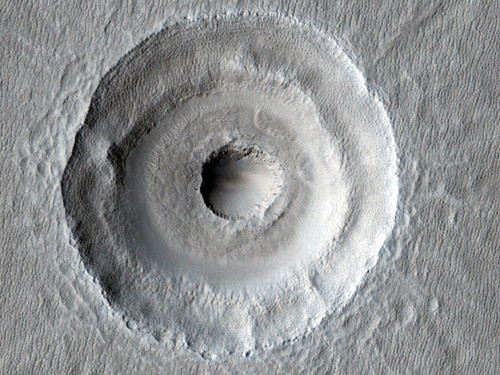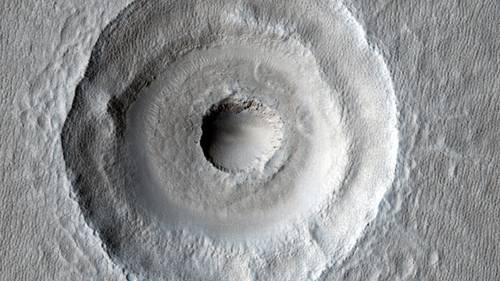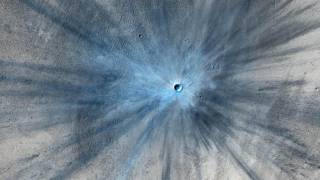Mars’s remarkable Bull’s-Eye Crater
Source: io9.com
This unusual crater was photographed from 190 miles up by NASA’s Mars Reconnaissance Orbiter.
Craters with multiple rims - the Bull’s-Eye Crater appears to have at least three - aren’t entirely unknown, although we’ve never found one before that’s so small. The ones we’ve previously discovered, such as the Moon’s Orientale Basin, are hundreds of miles across, whereas this Crater is a mere 2,300 feet across, less than half a mile wide. As such, its origin presents a mystery to astronomers, and there are two competing solutions.
The first theory is based on the fact that the crater is located in a vast northern plain that NASA believes sits above huge ice deposits. It’s possible that a rock the size of a large building crashed into the ancient surface with enough force to punch through the ice layer to the bedrock below. This disturbance of multiple layers would cause different ripples to form in the crater above, creating the nested pattern we now see.

One piece of circumstantial evidence strengthening this theory is another crater located about a half mile from the Bull’s-Eye Crater. As you can see here, that crater also has a secondary structure inside it, suggesting it was formed through a similar process of multiple layer disturbances. This might be an area of the plain where the ice layer and the bedrock beneath are of the right thicknesses to promote the creation of layered craters.
Unfortunately, there are a couple problems with this theory. The second crater inside the Bull’s-Eye is almost symmetrical, but it isn’t exactly symmetrical, and that’s a serious issue. The crater’s raised rim also doesn’t fit with a layered impact theory, and there are a couple waves in the upper right corner of the crater that might be evidence of landslides caused by a second impact.
That’s right - the other theory suggests that not one, but two different rocks hit the Bull’s-Eye. (If that’s the case, its name is even more appropriate than we thought.) It’s not impossible, but it is unlikely for two different rocks to hit such a small area, and it still doesn’t explain how that second, smaller crater got its layered shape.
So we’re left with two unlikely (but awesome) theories that both explain about 80% of the data we’re presented with, but neither can fully explain everything. Well, I guess we’ll just have to go to Mars ourselves and get a closer look at the damn thing. Remind me to pack my case of comically over-sized darts. It is a bullseye, after all.
Article from: io9.com
Also tune into:
Richard C. Hoagland - Phobos an Ancient Alien Spaceship, Mars, NASA & Disclosure
Richard C. Hoagland - The Shemsu Hor (Sons of Horus), Ancient Cosmic War, Space Rituals & The Moon
George J. Haas & William R. Saunders - The Martian Codex
George J. Haas & William R. Saunders - The Martian Codex Continued
Andrew D. Basiago - Comments, Questions & Answers
Andrew D. Basiago - Teleportation Trip to Mars & Life on Mars - Two Parts
Alfred Webre - Exopolitics, NASA Bombing of the Moon, Outer Space Treaty & E.T.
Mike Bara - Dark Mission, The Occult NASA Moon Mission
Ted Twietmeyer - What NASA isn’t Telling you about Mars
Joseph P Farrell - Cosmic War, Interplanetary Warfare & Mesopotamian Mythology






















